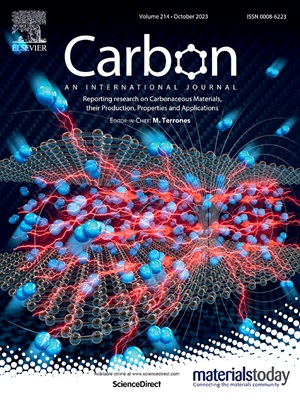Step-temperature strategy enables closed-pores in hard carbon achieving high plateau capacity for sodium ion storage
IF 11.6
2区 材料科学
Q1 CHEMISTRY, PHYSICAL
引用次数: 0
Abstract
Hard carbon (HC) has become the most promising anode material for sodium ion batteries (SIBs) due to its high reversible capacity, adjustable conductivity and low platform potential. However, the presence of numerous defects often results in relatively low capacity in the low-voltage plateau region (<0.1 V) and poor initial Coulombic efficiency (ICE). Closed pores in HC are widely regarded as a critical factor for enhancing plateau capacity. In this study, we utilized step-temperature strategy to stabilize the oxygen-centered radicals in biomass, which in turn mediated the topological reconstruction process of carbon microcrystals. This strategy increases the closed porosity of HC by accurately adjusting the curvature of the carbon layer, promotes the orderly reorganization of the carbon layer, and inhibits the problem of low closed porosity caused by excessive structural crosslinking. On this basis, the optimized HC has a high specific capacity of 339 mAh g−1 at 100 mA g−1, and has an ultra-high capacity retention rate of 97.5 % after 100 cycles. The platform capacity is increased from 142 mAh g−1 to 232 mAh g−1, and ICE is increased to 80.1 %. Furthermore, the electrochemical mechanism of sodium storage under pore structure regulation was investigated using in situ Raman spectroscopy, elucidating the electrochemical reactions during different sodiation-desodiation processes.

步进温度策略使硬碳的闭孔实现了钠离子存储的高平台容量
硬碳(HC)具有可逆容量大、电导率可调、平台电位低等优点,已成为钠离子电池最有前途的负极材料。然而,大量缺陷的存在往往导致在低压平台区(<0.1 V)容量相对较低,初始库仑效率(ICE)较差。HC中的封闭孔隙被广泛认为是提高高原容量的关键因素。在本研究中,我们利用步进温度策略来稳定生物质中的氧中心自由基,从而介导碳微晶的拓扑重建过程。该策略通过精确调节碳层曲率增加HC的闭合孔隙度,促进碳层有序重组,抑制过度结构交联导致的闭合孔隙度低的问题。在此基础上,优化后的HC在100 mA g−1时具有339 mAh g−1的高比容量,并且在100次循环后具有97.5%的超高容量保持率。平台容量从142 mAh g−1增加到232 mAh g−1,ICE增加到80.1%。此外,利用原位拉曼光谱研究了孔隙结构调控下钠的电化学储存机理,阐明了不同钠-脱钠过程中的电化学反应。
本文章由计算机程序翻译,如有差异,请以英文原文为准。
求助全文
约1分钟内获得全文
求助全文
来源期刊

Carbon
工程技术-材料科学:综合
CiteScore
20.80
自引率
7.30%
发文量
0
审稿时长
23 days
期刊介绍:
The journal Carbon is an international multidisciplinary forum for communicating scientific advances in the field of carbon materials. It reports new findings related to the formation, structure, properties, behaviors, and technological applications of carbons. Carbons are a broad class of ordered or disordered solid phases composed primarily of elemental carbon, including but not limited to carbon black, carbon fibers and filaments, carbon nanotubes, diamond and diamond-like carbon, fullerenes, glassy carbon, graphite, graphene, graphene-oxide, porous carbons, pyrolytic carbon, and other sp2 and non-sp2 hybridized carbon systems. Carbon is the companion title to the open access journal Carbon Trends. Relevant application areas for carbon materials include biology and medicine, catalysis, electronic, optoelectronic, spintronic, high-frequency, and photonic devices, energy storage and conversion systems, environmental applications and water treatment, smart materials and systems, and structural and thermal applications.
 求助内容:
求助内容: 应助结果提醒方式:
应助结果提醒方式:


